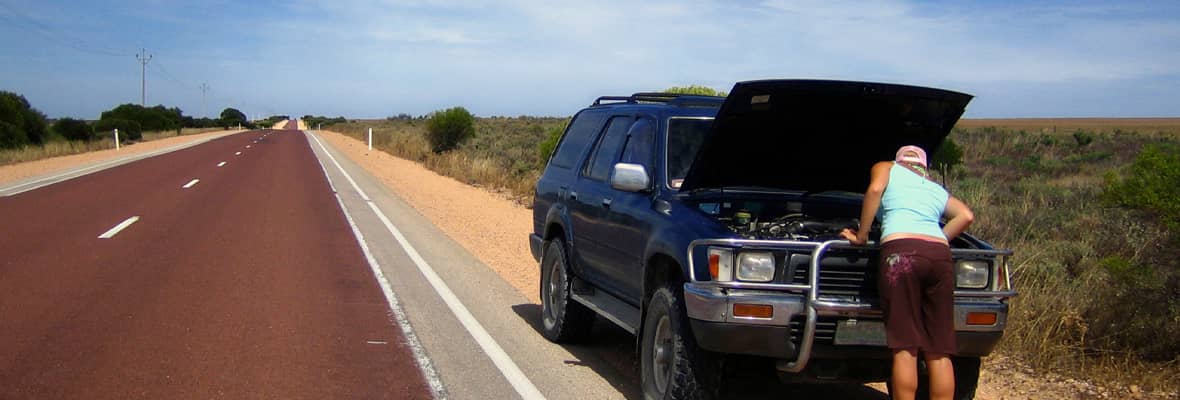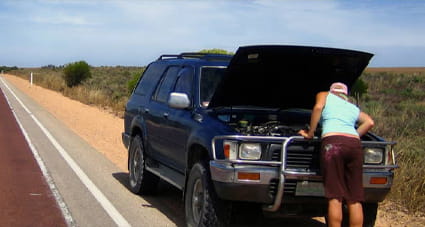Related articles
- How to change a car tyre
- Car maintenance and servicing checklists
- How to change a car battery
- 16 things to put in a car emergency kit
- Roadside assistance buying guide
- What to do if your car breaks down on a highway
- How to get your car unstuck from mud or sand
- Australia Day road trips survey 2021
- Best road trips Australia
- Roadside Assistance Survey & Statistics 2022 | Budget Direct
- Tips for maintaining your car while not in use
- Warning signs your car might break down soon
- How to check and add oil to your car
- Tyre health survey 2020
- How to get the ideal tyre pressure for your car
- How to transport your bike by car
- Common roadside callouts 2021
- Family Road Trips Survey & Statistics 2022
- Road Trip Planner Australia
A car breakdown is a hassle – but don’t make it worse
Car breakdowns can happen to anyone at any time: in the middle of the city, on the way to work, in your own driveway, in a remote area or on the side of a busy road.
And they can happen for all sorts of reasons – a dead battery, a mechanical fault, running out of fuel, a flat tyre.
Finding a safe place to stop can be a real challenge when your car conks out on you.
A British survey asked drivers to list their most stressful breakdown scenarios, and ‘on the way to the airport to catch a flight’ came out well on top, with 56% of respondents citing this as the most stress-inducing situation. Additional unpleasant scenarios included:
- Being out driving in foul weather (especially rain or snow) – 43%
- Driving overseas – 31%
- Driving with children/family in the car – 27%
- Breaking down on a busy motorway – 27%
- Breaking down in an isolated/rural area – 23%
- Having a car breakdown at night – 23%
- Breaking down in an unfamiliar area – 17%
- Breaking down when alone in the car – 15%
(You can reduce the stress of a breakdown by becoming a Budget Direct Roadside Assistance member. Wherever you are in Australia, whatever the time of day or night, if your car goes kaput and you need help to get going again, you can call us.)
Busy motorways and narrow roads with minimal shoulders are dangerous places to have a breakdown. When there’s insufficient room to get well off the road or you’re not clearly visible until other drivers are nearly on top of you, you can create a serious hazard for yourself and others.
In New South Wales alone, there were 145 breakdown lane/road shoulder crashes between 2007 and 2011. These resulted in 103 injuries and eight deaths.
Research by the NCIS (National Coroners Information System) examined deaths that occurred after cars had stopped in an emergency lane and found that heavy trucks ploughing into stationary vehicles were the most common kind of incident and that these types of deaths were more likely to happen to males in the 20-49 age group.
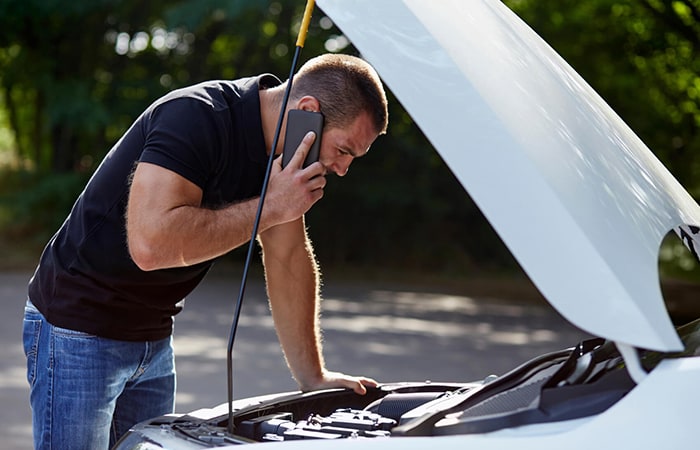
While some of us are quite capable of changing a tyre under normal circumstances, there are times when it’s safer to call your Roadside Assistance provider to get help. A simple task isn’t always so simple (or safe) when you’re perilously close to oncoming traffic whizzing by at high speed.
Why has your car broken down?
Cars break down for all sorts of reasons and you can’t foresee every possibility. However, the best antidote to car breakdowns is preparation. The vast majority of breakdown issues are thoroughly preventable.
Flat or faulty batteries are a major cause of car problems. If you’re lucky, you may get 3-5 years from a new car battery. Sometimes, you might only get a year. Have your battery tested for charge twice a year. You’ll stay ahead of any issues and keep an eye out for dodgy clamp connections and corroded terminals. If your battery requires regular electrolyte top-ups, don’t forget those. Read our guide to replacing a car battery.
Your car’s tyres are literally ‘where the rubber meets the road’, so make sure you look after them. Steer clear of debris on the streets, maintain the right air pressure and don’t let tyres get too bald. A tyre blowout or a fine from an eagle-eyed policeman conducting a road safety stop will pick this up. Keep your spare tyre in good condition too. If you’ve never changed a flat tyre in your life, that’s okay – now is the perfect time to get in some practice so you’ll be ready when the time comes. Read our guide to changing a car tyre.
If you’re like most people and someone asks you how your alternator is performing, your most likely response will be “What’s an alternator?” However, these cantankerous gizmos can play up pretty regularly in vehicles and it’s worth knowing how to spot a dying one. Usually, a red light on your dashboard is the first hint that your alternator is failing. If your headlights start dimming for no apparent reason or there is other evidence of quick loss of electrical power (or rising engine temperatures), those symptoms are a clue as well. If any of these things happen, it’s time to get your alternator checked out by a mechanic as soon as possible.
It sounds too obvious to mention, but make sure you’re putting the correct fuel in your vehicle too. These days, there are more fuel options available than ever before – but that also means there are more chances for car owners to make a mistake. Another all-too-common cause of breakdowns is running out of petrol. There’s no real excuse for this – you just have to plan ahead and not let the fuel gauge get too low. There are plenty of apps available these days that can tell you where the nearest petrol station is and what current fuel prices are.
How To Stay Safe
There are a number of steps you can take to improve safety if your car breaks down. Here are some recommendations:
- Look for the safest place to pull over; park as far to the left as is safely possible.
- Turn on your hazard lights (and your parking lights if visibility is poor).
- Check for traffic before exiting the vehicle and avoid crossing the road at all times.
- Stand well off the road – not on it; move behind safety barriers if any are available and it’s safe to do so.
- Call Roadside Assistance on your mobile phone (or use a roadside emergency phone if one is available and can be safely reached). Follow their instructions when they arrive.
- Leave your vehicle from the passenger side if feasible, away from traffic.
- If it’s not safe to leave your car, remain in the vehicle with your seatbelt fastened.
- Vigilance and constant awareness of your surroundings is crucial to ensuring your breakdown doesn’t result in safety issues for you and other drivers.
Carry a car emergency kit
Sometimes, even with good preparation and the best intentions, life happens – and that’s when it’s important to have a few basic items with you to handle the unexpected. A basic car emergency kit should contain:
- Charged mobile phone – this is crucial so you can summon help, check your GPS location, locate the nearest service station.
- Car Charger- It’s worth investing into a good phone charger. Car-based USB chargers can keep your phone running.
- Fire extinguisher – it’s amazing how many cars don’t have one, but it could save your life
- Tyre gauge – a pocket-sized gauge can check tyre pressure in an instant
- Basic first aid kit – pack some plasters, tape, antiseptic, aspirin and essential medications
- Plastic rain poncho or raincoat – sometimes tyre-changing weather can turn soggy
- Water – always carry spare water for both you and your radiator
- Multi-tool – a basic tool (with screwdriver) can come in handy
- Rags – useful for all sorts of things when your car breaks down
- Torch and spare batteries – breakdowns often occur at night
Tunnel Vision
If you break down in a tunnel, activate your hazard lights and parking lights immediately.
Stay in the vehicle with your seatbelt fastened. Major tunnels are monitored and operators will send assistance as soon as they can. Help may take longer than expected because of the gridlock that a tunnel breakdown can cause, so be patient.
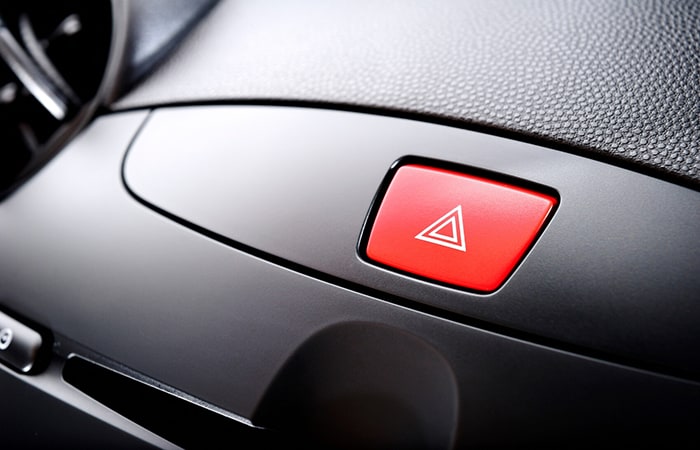
Obey any instructions given to you by the tunnel operator over your radio. Rest assured, help will come: when you break down in the middle of a tunnel, usually half the city knows about it within a few minutes – especially if it occurs during rush hour!
In More Remote Areas
While a busy city has its share of challenges when it comes to car breakdowns, at least help is usually close at hand.
In less populated parts of Australia, self-sufficiency and thorough preparation are even more crucial. Your mobile might be out of range, there may be little (or no) traffic and you could end up being stuck in your breakdown spot for hours or in rare cases, you may be stuck for days.
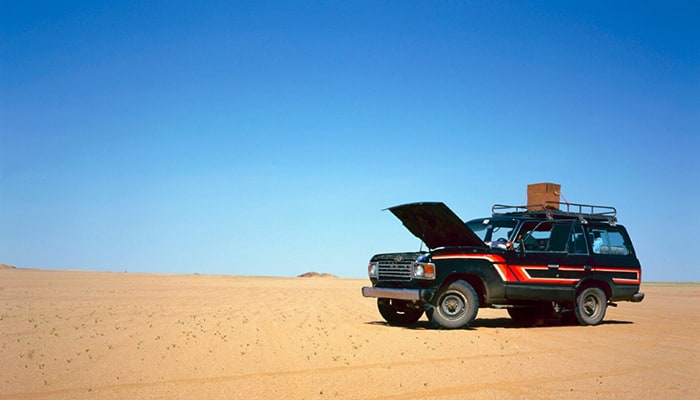
If you’re planning on driving in remote areas, your vehicle should be in tip-top condition before you depart. Bring a satellite phone or some other form of remote-area communication. Carry plenty of water, extra fuel, essential spare parts and sufficient spare tyres for the intended journey.
Roadside assistance
We provide roadside assistance 24/7 anywhere in mainland Australia, Tasmania and Phillip Island that can be accessed by two-wheel-drive recovery vehicle.
For $89.95 a year — the equivalent of $1.75 per week — that’s a small price to pay for peace of mind.
If you’re already a member and you’ve broken down and need help, please call 1800 514 448.
Sources
http://www.tmr.qld.gov.au/safety/driver-guide/tunnel-safety.aspx
https://www.theaa.com/breakdown-cover/news/most-stressful-breakdown-situation.html
http://www.budgetdirect.com.au/roadside-assistance-australia/guides/what-should-you-do-if-your-car-breaks-down-on-a-busy-highway.html
http://www.bankrate.com/auto/20-must-haves-in-your-car-emergency-kit/
Related articles
- How to change a car tyre
- Car maintenance and servicing checklists
- How to change a car battery
- 16 things to put in a car emergency kit
- Roadside assistance buying guide
- What to do if your car breaks down on a highway
- How to get your car unstuck from mud or sand
- Australia Day road trips survey 2021
- Best road trips Australia
- Roadside Assistance Survey & Statistics 2022 | Budget Direct
- Tips for maintaining your car while not in use
- Warning signs your car might break down soon
- How to check and add oil to your car
- Tyre health survey 2020
- How to get the ideal tyre pressure for your car
- How to transport your bike by car
- Common roadside callouts 2021
- Family Road Trips Survey & Statistics 2022
- Road Trip Planner Australia
